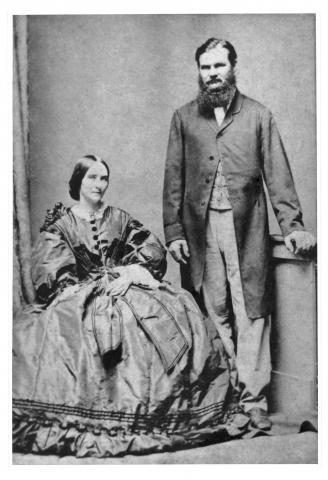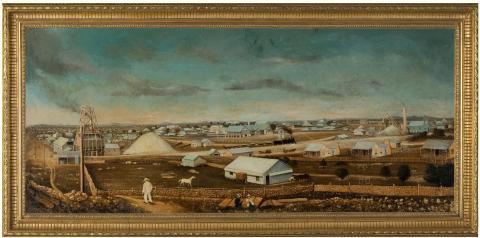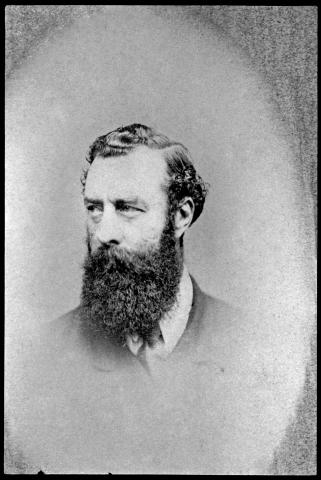
- News of the day
-
TBA
- Biography of Richard Daintree
-
Richard Daintree (1832-1878), geologist and photographer, was born on 13 December 1832 at Hemingford Abbots, Huntingdonshire, England, son of Richard Daintree, farmer, and his wife Elizabeth. He matriculated at Christ's College, Cambridge, in 1851, but left after a year because of ill health and in 1852 joined the gold rush to Victoria. Unsuccessful as a prospector, he accepted appointment in February 1854 as assistant geologist to his friend, Alfred Selwyn, in the Victorian Geological Survey, and served with it until 1856. On a visit to England to study assaying and metallurgy at the Royal School of Mines Laboratory, he became interested in photography, and on his return to Melbourne in 1857 may have collaborated with Antoine Fauchery in a volume of photographic studies modestly entitled Australia. When he rejoined the Geological Survey as a field surveyor in January 1859, he pioneered the use of photography in field-work. In the next five years his routine duties included mapping and search for coal seams, and his growing dissatisfaction with this life was not assuaged by controversy with Professor Frederick McCoy in defence of the palaeontological theories of William Branwhite Clarke for whom Daintree developed an almost filial regard.
In 1864 Daintree left the Geological Survey to become a resident partner with William Hann in pastoral properties in the new Burdekin country of North Queensland. There Daintree was able to indulge his taste for both photography and prospecting. His discoveries in 1865-67 included several indications of gold, a copper deposit on the Einasleigh and the first systematic examination of the Bowen River (Collinsville) coal seams. When the pastoral boom collapsed Daintree used his knowledge to open up goldfields at Cape River in 1867, Gilbert in 1869 and Etheridge in 1869-70; they played an important part in tiding North Queensland over the depression, although only the Etheridge proved permanent and was soon overshadowed by other finds. But for Daintree's pioneering work in attracting prospectors to North Queensland, the gold resources of this area would probably not have been developed so early.
Daintree advocated a government geological survey in Queensland, and when it began in 1868 he was geologist in charge of the northern division until 1870. In that year he made some of his finest photographic studies. At the 1871 Exhibition of Art and Industry in London, Daintree's collection of photographs and geological specimens formed the mainstay of Queensland's contribution, and he was sent to England as commissioner in charge of this display, although much of it was lost when the ship carrying Daintree and his family was wrecked. In London he soon established himself as an enthusiastic and effective propagandist for Queensland and, on the unexpected resignation of Archibald Archer as Queensland's agent-general, was appointed to the vacancy early in 1872. With great energy he stimulated assisted immigration to Queensland, travelled widely to lecture on the colony's resources and produced attractive handbooks illustrated by his own photographs. From 1874, however, his administration was increasingly criticized by the premier, Arthur Macalister, who was disturbed by the quality of some of the new migrants and by growing evidence of inefficiency in the agent-general's staff. Eventually in the winter of 1875-76 Macalister went to London; his personal investigation revealed that Daintree, although thoroughly honest and hard-working, had trusted the routine business of his office to clerks who used their expertise as a cover for various malpractices. The offenders were dismissed and Daintree, whose health had deteriorated, resigned in 1876. Daintree wintered twice in south France, hoping to recover enough strength to devote himself to the study of petrology. He continued to attend scientific meetings but succumbed to tuberculosis and other ailments at Beckenham, Kent, on 20 June 1878, soon after his appointment as C.M.G. In Melbourne on 1 December 1857 he had married Lettice Agnes, daughter of Henry Foot, a surveyor of Brighton; she survived him with two sons and six daughters.
Daintree's importance as a pioneer geologist lies more in his work as prospector than in the controversies in which he was involved. His photographs, taken under difficult conditions by the cumbersome wetplate process, are superb specimens of the art and present a vivid picture of early settlement in Queensland. His enthusiasm, skill and capacity for friendship distinguished him in his profession, although these qualities were not enough to make him a success in the agent-general's office or to avoid the tragedy of his last years.
Courtesy of the Australian Dictionary of Biography



